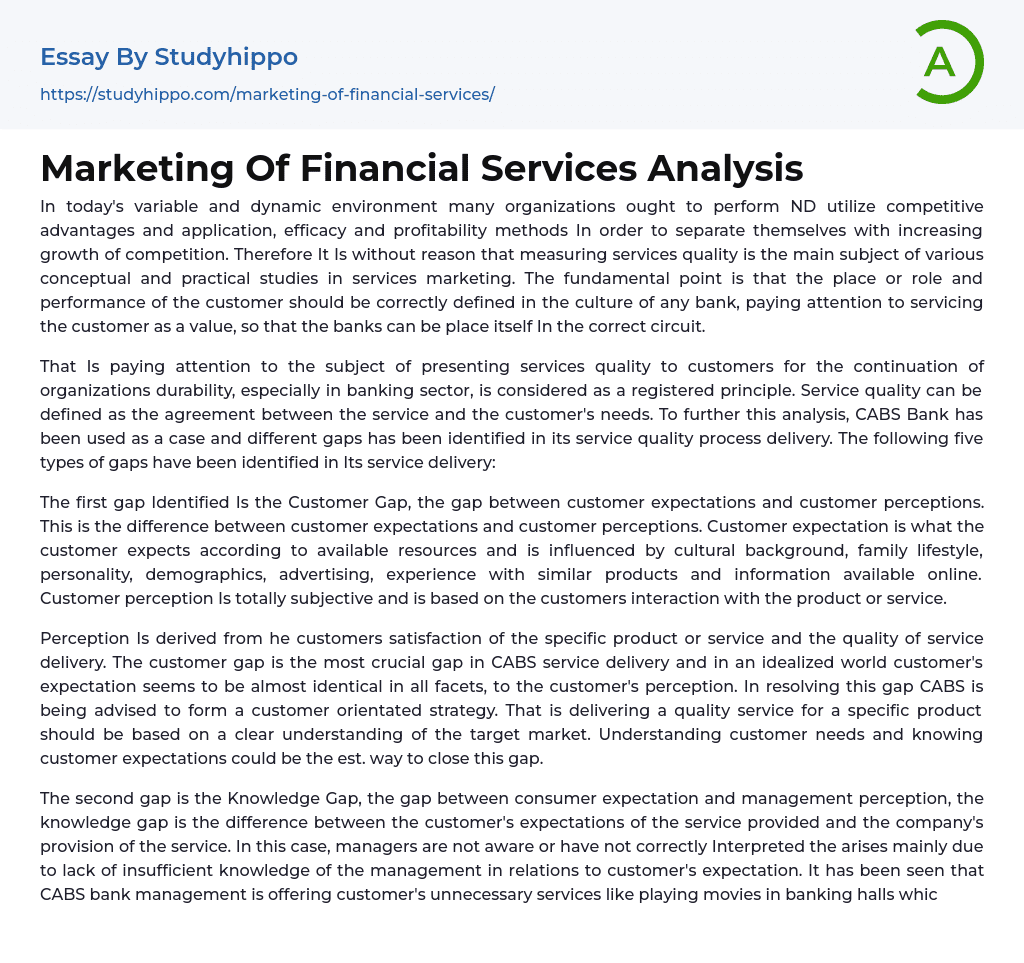In today's competitive environment, organizations need to differentiate themselves and gain a competitive advantage. Measuring service quality is important, especially in the banking industry. Banks must prioritize delivering value and meeting customer expectations to ensure long-term success. In analyzing CABS Bank as a case study, several gaps in its service quality process have been identified. The first gap, known as the Customer Gap, refers to the difference between customer expectations and perceptions. Customer expectations are influenced by various factors such as resources, culture, lifestyle, demographics, advertising, previous experiences, and online information. Customer perception is subjective and shaped by their satisfaction levels and overall service quality. The most significant gap occurs when there is a mismatch between customer expectations and perceptions - this is referred to as the customer gap.
The ideal situation occurs when customer expectations closely
...match their perception of the product or service. To resolve this difference, it is recommended that CABS adopts a customer-focused approach by offering high-quality service for a specific product, based on a clear understanding of the target market. Bridging this gap requires effectively comprehending and meeting customer needs and expectations.
The Knowledge Gap refers to the disparity between consumer expectations and management's perception. It arises when managers are unaware or have misunderstood customer expectations due to insufficient knowledge. In the case of CABS bank management, providing unnecessary services like playing movies in banking halls does not benefit customers and indicates a lack of understanding of their expectations. This misunderstanding can lead to poor decision-making and ineffective allocation of resources.
Conducting market research would assist CABS management in accurately identifying market needs and bridging the gap between customer expectations and management'
perception of service delivery. Lastly, there is also a policy gap between management's perception and service quality specifications. Gasper et al claim that managing CABS struggles to meet consumer expectations and provide high-quality service, leading to a discrepancy between customer-oriented service criteria and actual bank staff performance.The reasons for this gap can include poor service design, a lack of customer service updates, or a lack of standardization. According to Loco and Mac.Dog (1996), customer satisfaction relies heavily on service performance. Consequently, customers may opt to find similar products with better service elsewhere.
This gap signifies a disconnection between the specification and delivery of service quality, exposing weaknesses in employee performance. Organizations facing this delivery gap may have identified necessary service requirements but failed to adequately train their employees or implement effective processes and guidelines. As a result, employees are ill-equipped to meet customer needs.
Moreover, the delivery gap can lead to issues such as employees lacking product knowledge and struggling with customer questions and problems. Additionally, organizations may have insufficient human resource policies that hinder the formation of cohesive teams for efficient delivery.
Furthermore, there can be a discrepancy when performance and commitments do not align, leading to a disconnect between service delivery and external communications. This problem is partially caused by CABS' tendency to make promises through advertising and communication channels that create high customer expectations. However, if these promises do not match the actual service provided, it creates a gap in communication.As a result of inadequate coordination between the advertising and description team and the team responsible for presenting the actual services, customers may opt for alternative products or sources if their expectations are not fulfilled.
When those in charge of advertising lack accurate knowledge about the service, it can lead to exaggerated commitments and misleading advertisements. Ultimately, this creates disparities between customer expectations and the actual services delivered.
- Chief Executive Officer essays
- Convenience Store essays
- Firm essays
- Training And Development essays
- Unilever essays
- Variable Cost essays
- Virgin Group essays
- Bargaining essays
- Entity essays
- Pest analysis essays
- Advertising essays
- Audience Theory essays
- Competitor Analysis essays
- Consumer essays
- Marketing Management essays
- Marketing Mix essays
- Marketing Plan essays
- Marketing Research essays
- Marketing Strategy essays
- Point Of Sale essays
- Price essays
- Procurement essays
- Product essays
- Product Differentiation essays
- Promotion essays
- Promotion And Marketing Communications essays
- Retailing essays
- Trademark essays
- Anheuser-busch essays
- Brands essays
- Detergent essays
- Product Placement essays
- Research Design essays
- New Product Development essays
- Advertisement essays
- Brand essays
- Sales Promotion essays
- Advertising campaign essays
- Consumer behaviour essays
- Offer And Acceptance essays
- Wal-Mart essays
- Discover essays
- John Locke essays
- 9/11 essays
- A Good Teacher essays
- A Healthy Diet essays
- A Modest Proposal essays
- A&P essays
- Academic Achievement essays
- Achievement essays




